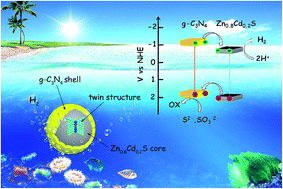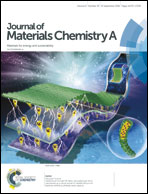Novel Zn0.8Cd0.2S@g-C3N4 core–shell heterojunctions with a twin structure for enhanced visible-light-driven photocatalytic hydrogen generation†
Abstract
A series of novel core–shell nanocomposites composed of twinned nanocrystal Zn0.8Cd0.2S solid solution and porous g-C3N4 nanosheets were fabricated by a combined ultrasonication and solvothermal method. The photocatalytic hydrogen production activities of these samples were evaluated without a co-catalyst in water under visible light irradiation (λ ≥ 420 nm). It is found that the H2 production rate of the Zn0.8Cd0.2S@g-C3N4-10 wt% sample was 2351.18 μmol h−1 g−1, which is 146.0 and 5.7 times higher than that of pristine porous g-C3N4 nanosheets and Zn0.8Cd0.2S solid solution. Further detailed characterization reveals that the drastically enhanced and stable light-to-hydrogen energy conversion can be attributed to not only the efficient spatial separation of the photo-induced electrons and holes resulted from the synergetic effects of twinned homojunctions and core–shell heterojunctions, but also the intimate contact at the molecular scale between the porous g-C3N4 shell and Zn0.8Cd0.2S core. Therefore, this work puts forward a promising way to obtain unique core–shell heterojunctions with excellent stability and activity during a photoreaction process.



 Please wait while we load your content...
Please wait while we load your content...